Weekly statistics for rapid asymptomatic testing in England: 29 April to 5 May 2021
Updated 13 May 2021
Applies to England
Introduction
This statistical publication aims to provide information on rapid testing for people without COVID-19 symptoms in England. This includes:
- the number of LFD tests conducted by test result
- the number of LFD tests conducted education settings
- the number of LFD and PCR tests conducted in care homes
- the number of LFD tests conducted by NHS staff
This publication focuses on rapid testing using lateral flow device (LFD) tests, however polymerase chain reaction (PCR) tests are included where appropriate, either for comparison or where regular asymptomatic PCR testing is used. All data used in the report can be found in the ‘Tests conducted’ data tables on the weekly collection page. This includes information on both LFD and PCR tests at lower-tier local authority level.
The data in this release can be used to:
-
determine the effectiveness of NHS Test and Trace in the expansion of rapid asymptomatic testing
-
monitor the levels of testing and positive test results amongst various settings such as in education, care homes and by NHS staff
This data should not be used to:
-
calculate the prevalence of COVID-19 in the wider population
-
calculate case positivity rates, the reasons for which are explained in the About this data section below
-
assess the effectiveness of the testing types used in England
-
compare the mass testing programmes across nations
PCR and LFD case positivity rates are published within National flu and COVID-19 surveillance reports and PCR positivity rates are also published on the coronavirus in the UK dashboard.
The figures in this report include LFD tests which were registered through the National Testing Programme digital infrastructure. They also now include the number of tests reported by secondary care NHS staff which were registered via a different route. They do not currently include a relatively small number of LFD tests conducted within private sector testing.
See the About this data section below for more information.
Background
Types of tests
PCR tests
PCR tests check for the genetic material of the coronavirus in the sample, which is taken using a swab and is processed in a lab via a polymerase chain reaction (PCR). This type of test is predominantly used for:
- anyone who has symptoms
- to confirm a positive LFD test result
- regular asymptomatic testing in social care
Lateral flow device tests
LFD tests, often referred to as rapid tests, test for the presence of proteins called ‘antigens’ which are produced by the virus. They are swab tests that give results in 30 minutes or less, without the need for processing in a laboratory. These tests are primarily used for those who do not have symptoms.
From 21 October 2020, LFD tests were made available in limited capacity except where rapid testing pilots were conducted. Since then their availability has expanded, initially to a broader range of settings and from 9 April 2021 to everyone in England.
Prior to 27 January 2021, if an individual received a positive LFD test result they were required to take a PCR test to confirm this. Between 27 January and 29 March 2021 this was no longer a requirement except for those self-reporting their test result. From 30 March 2021 the requirement to take a confirmatory PCR test was reinstated for all positive LFD tests.
Rapid testing for people without symptoms
Rapid testing using LFD tests is currently being offered to people who do not have symptoms, in a range of different settings such as education providers, care homes and workplaces. In addition, anyone in England is now eligible for twice weekly LFD tests, see regular rapid coronavirus tests if you do not have symptoms guidance for more information.
Some LFD testing is carried out at asymptomatic test sites, which are deployed in a range of community settings such as universities, schools, care homes and workplaces. They are also set up by local authorities as part of the community testing programme. Testing at these sites is assisted: a person will take a swab test under the supervision of a trained operator who then processes the test then reads and records the result.
Some LFD testing is carried out entirely by individuals themselves (that is an individual takes their own test, unassisted, and reports their own result). For more information see understanding lateral flow tests for people without symptoms.
LFD tests conducted, England[footnote 1]
Between 18 February and 17 March, the number of LFD tests conducted rose sharply, peaking at just over 7.6 million, which coincided with the return of secondary students to school. Following that peak, the number of LFD tests conducted reduced sharply in the week commencing 1 April, to just over 4 million. The reduction coincided with the end of spring term in schools. Between 8 April and 21 April, the number of LFD tests increased following the start of summer term and the introduction of universal testing. Since then, the number of LFD tests conducted has decreased to 5,103,929 tests in the latest week (29 April to 5 May 2021).
In comparison, 852,503 PCR tests were conducted in the latest week (29 April to 5 May 2021). The number of PCR tests conducted continues to be lower than the number of LFD tests conducted. This reflects the increasing use of LFD tests, as well as a decrease in symptomatic people taking a PCR test due to decreasing COVID-19 prevalence.
PCR and LFD tests have different uses and are therefore applied in different situations (see the Types of tests section above for more information). The primary purpose of rapid LFD testing is to identify people with COVID-19 who do not have symptoms. As the number of LFD tests conducted increases, more asymptomatic positive cases are identified earlier and therefore they are less likely to transmit the virus to their contacts.
Of the LFD tests conducted in the latest week, 5,966 tests returned a positive result, and 5,092,288 tests returned a negative result. Since LFD tests were introduced, 158,082 positive results and 68,711,368 negative results have been reported.
Figure 1: number of LFD and PCR tests conducted, England
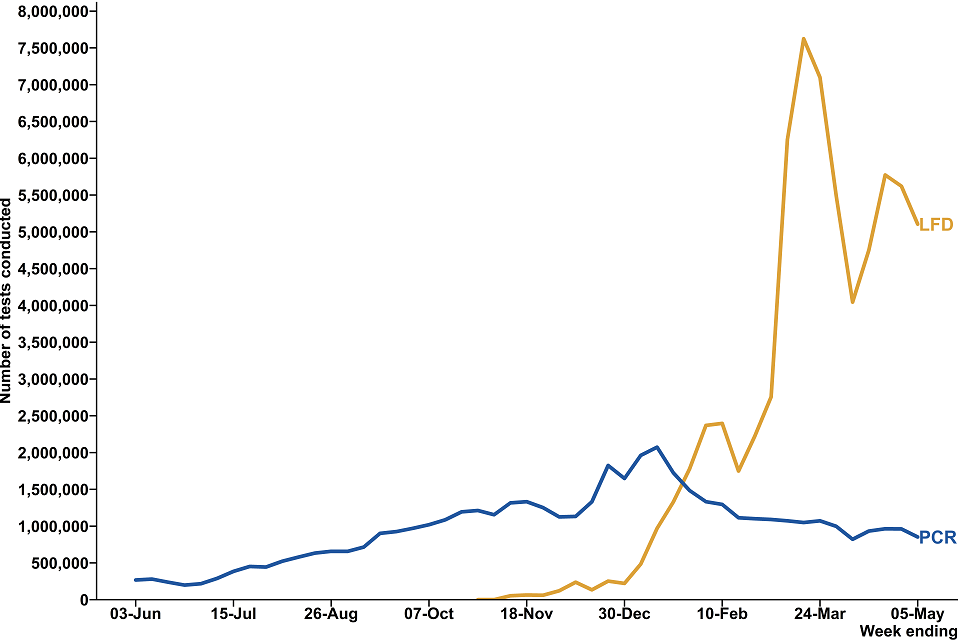
This data can be found in the ‘table_1’ and ‘table_3’ tabs of the ‘Tests conducted: 28 May 2020 to 5 May 2021 data tables’ on the weekly collection page.
The total number of LFD tests conducted does not include tests taken by staff in NHS trusts as they report via a different route.
These figures are reported separately in the section for tests conducted by staff in NHS trusts and have an additional week’s time lag (because they are collated weekly by trusts). The data therefore cannot be combined on a weekly basis to give an overall total number of LFD tests conducted.
LFD tests conducted in education settings, England
The rapid testing operation has been rolled out differently across the different education settings, as summarised in the table below. For more information see the NHS Test and Trace statistics methodology.
| Testing started | Frequency | Group tested | |
|---|---|---|---|
| Primary schools, school-based nurseries and maintained nursery schools | 18 January 2021 | Twice a week | Staff |
| Primary schools, school-based nurseries and maintained nursery schools | 1 March 2021 | Twice a week | Households and bubbles of staff and students |
| Secondary schools and colleges | 4 January 2021 | Once a week then increased to twice a week | Staff and students* |
| Secondary schools and colleges | 8 March 2021 | Three tests on return (spaced 3 to 5 days apart) then twice a week | Students |
| Secondary schools and colleges | 1 March 2021 | Twice a week | Households and bubbles of staff and students |
| Higher education | 27 November 2020 | Twice before leaving and twice on return | Staff and students |
| Higher education | 25 January 2021 | Twice a week | Staff and students |
*Students in this time period only included children of critical workers and those in vulnerable groups who were currently attending school.
Between 27 January and 30 March 2021, staff, students, household bubbles and support bubbles who tested positive after using a home LFD test kit were required to take a confirmatory PCR test, and those who tested positive from an LFD test taken at an on-site test centre did not. From 30 March 2021, the requirement to take a confirmatory PCR test was reinstated for all positive LFD tests. For more information on the testing methods for the different phases of education see the NHS Test and Trace statistics methodology.
LFD tests conducted by phase of education
The number of LFD tests conducted within primary schools, school-based nurseries and maintained nursery schools increased substantially between 14 January 2021 and the beginning of February to over 700,000 tests in a week. In the latest week, the number of tests conducted has decreased to 812,351 compared to 884,784 tests in the previous week. 705 positive test results were returned in the latest week within primary schools and nurseries, a decrease from 721 positive results in the previous week.
Similarly, within secondary schools and colleges, the number of LFD tests conducted increased gradually since the week commencing 31 December 2020 to over 400,000 in the week commencing 4 February. In the latest week, the number of tests has decreased to 1,985,609 compared to 2,291,421 in the previous week. This follows an increase in tests in week ending 21 April which coincided with the start of the summer term for schools. Since then, the number of positive test results has decreased to 1,980 positive results in the latest week.
The total number of LFD tests taken in secondary schools and colleges includes tests not registered. The full breakdown of tests registered and not registered in secondary schools and colleges is available in ‘table 6’ of the ‘Tests conducted: 28 May 2020 to 5 May 2021 data tables’ on the weekly collection page.
57,229 LFD tests were conducted in the latest week in higher education, which is a decrease from 72,252 tests in the previous week. The number of LFD tests conducted in higher education peaked between 3 December to 9 December 2020 which coincided with students getting tested to enable them to travel home for the winter break. There has been a decrease in positive results in higher education in the latest week, with 34 positive test results returned.
The number of positive test results is not published as a proportion of the total tests conducted due to the data quality. In addition, because there are differences in the testing operation between the different phases of education, they cannot be directly compared. See the Data quality section below for more information.
Figure 2: number of LFD tests conducted in education, by phase of education, England
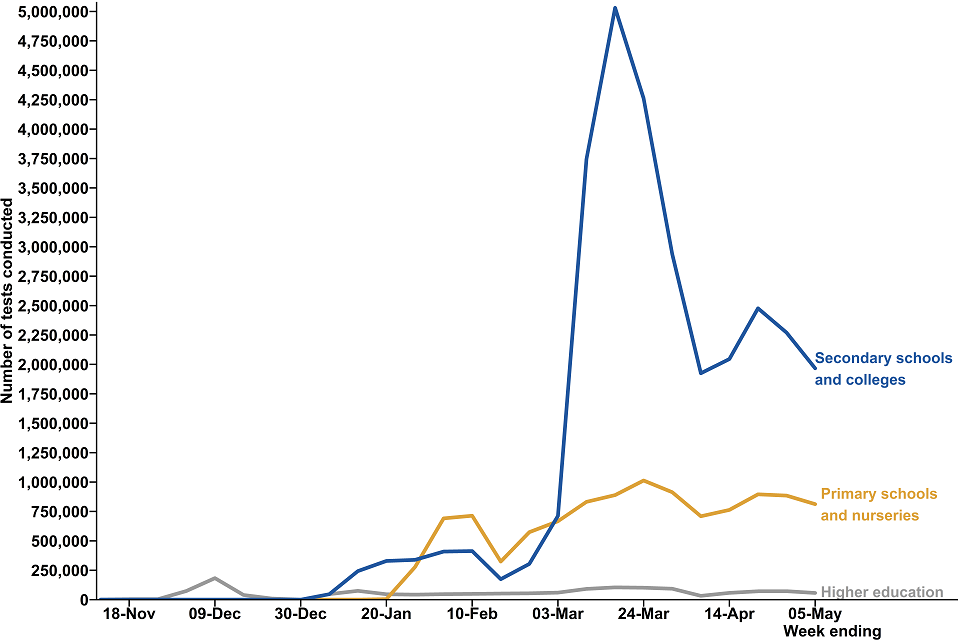
This data can be found in the ‘table_6’ tab of the ‘Tests conducted: 28 May 2020 to 5 May 2021 data tables’ on the weekly collection page.
LFD tests conducted by secondary school students
Upon their return to school from 8 March, secondary school students were tested for COVID-19 at school-specific asymptomatic test sites (assisted), with each student asked to take 3 tests spaced 3 to 5 days apart. Those students who received a positive LFD test result were not asked to take a confirmatory PCR test. After these first 3 tests, students begin twice weekly LFD testing at home (self-reported), for which they are advised to take a confirmatory PCR test within 2 days if they receive a positive result.
In the latest week ending 5 May, 1,228,727 LFD tests were taken by students in secondary schools which is a decrease from 1,436,448 tests in the previous week.
In the latest week ending 5 May, 1,289 positive LFD tests were received by secondary school students, of which 13 were assisted at a test site and 1,276 were self-reported[footnote 2]. Of those which were self-reported, 595 were matched to a confirmatory PCR test [footnote 3] and 374 received a subsequent positive PCR test result, the remaining 221 were negative or void. These figures therefore show that in the latest week 63% of positive LFD tests which could be matched to a confirmatory PCR test, subsequently received a positive PCR test result. The remaining 37% were negative or void, however there are multiple reasons why an LFD test result and a PCR test result might differ, these are listed in the section below.
Figures for confirmatory PCR tests taken by secondary school students after a positive LFD test result at an asymptomatic test site (assisted) are also published in the accompanying data tables.
These figures show the number of positive LFD tests declining as secondary school students moved to self-reporting their LFD tests after their first 3 tests on site on their return to school. The requirement for an individual to take a confirmatory PCR test after a positive LFD test result was reinstated for all positive LFD tests from 30 March 2021. Therefore, the confirmatory PCR data for those assisted LFD tests taken at asymptomatic test sites cannot be directly compared across the full time period or to those taken at home before 30 March 2021.[footnote 4]
There are a number of possible reasons why the results of the initial LFD and the confirmatory PCR may be different:
-
issues in correctly reading or recording the result for LFDs, leading to reporting a positive result when it was negative
-
the initial LFD may have incorrectly returned a positive result, which occurs in less than 1 in 1,000 tests
-
the confirmatory PCR may have incorrectly returned a negative result which can occur if the sampling technique was poor. See more information on false negatives in PCR testing
-
the time delay between the taking of the 2 tests means that it is possible for an individual to have correctly tested positive when they took the LFD and then correctly negative when they took the PCR. Of all the confirmatory PCRs identified for self-reported LFDs, 85% were taken within one day of the LFD test meaning this is unlikely to be the reason for the negative confirmatory PCR test
The data presented here is in line with previously published analysis by NHS Test and Trace on lateral flow device specificity, which shows LFD tests have a specificity of at least 99.9%. This means that for every 1,000 lateral flow tests carried out, there is fewer than one false positive result. The number of false positives as a proportion of all positive results varies depending on the prevalence of COVID-19 within the populations being tested – the higher the level of prevalence, the lower the probability that a positive result will be a false positive. For more technical information on LFD tests and false positives see NHS Test and Trace statistics methodology.
LFD tests conducted by staff, students, household bubbles and support bubbles
In the latest week 411,162 LFD tests were taken by staff in secondary schools, a decrease from the previous week. In comparison, 678,733 tests were taken by staff in primary schools, school-based nurseries and maintained nursery schools.
259,642 tests were taken by individuals that belong to a household bubble of a student or staff member at school or nursery and 32,259 were taken by individuals in their support bubbles. The number of tests conducted by household and support bubbles decreased in comparison to the previous week.
Figure 3: number of LFD tests conducted by staff and students in secondary schools, England
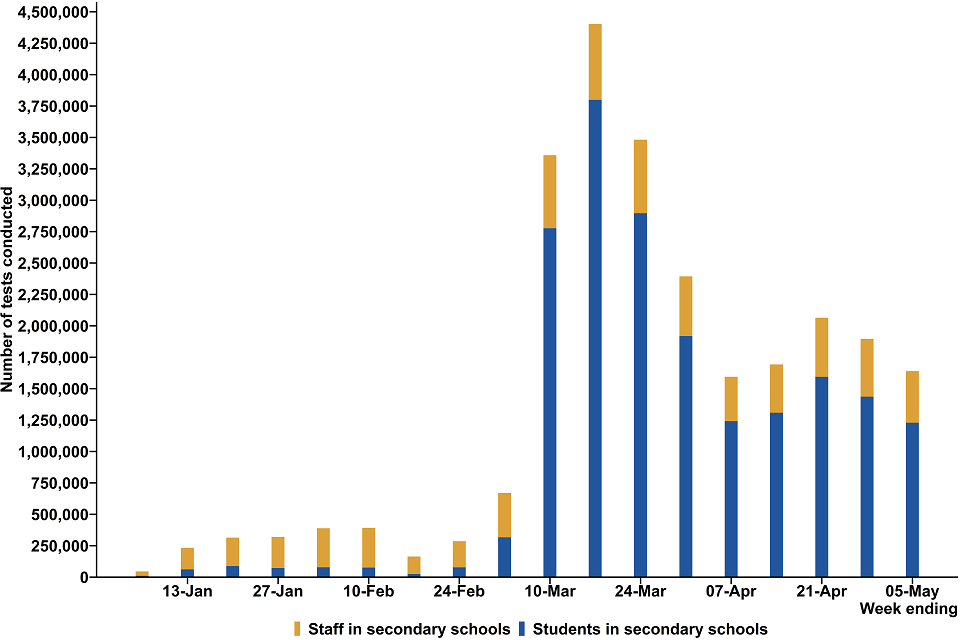
This data can be found in the ‘table_7’ tab of the ‘Tests conducted: 28 May 2020 to 5 May 2021 data tables’ on the weekly collection page.
Tests conducted and registered to care home settings, England
Asymptomatic testing, using both rapid LFD tests and PCR tests has been rolled out differently across different care home settings and their residents, staff and visitors, as summarised in the table below.
The number of tests conducted in care homes includes staff, residents and visitors tested via test kits directly sent to the care home which were registered. It will not include care home staff residents, or visitors who are tested via a different route, for example at a regional or local test site or a mobile testing unit or tests that were not registered.
For more information see the NHS Test and Trace statistics methodology.
| Dates | Frequency | Test kit | |
|---|---|---|---|
| Care home residents | 7 June 2020 to present | Monthly In the event of an outbreak: day 1 and between days 4 to 7 |
PCR |
| Care home residents | 22 February 2021 to present | In the event of an outbreak: day 1 and between days 4 to 7 at health protection team discretion | LFD |
| Care home staff | 7 June 2020 to present | Weekly In the event of an outbreak: day 1 and between days 4 to 7 |
PCR |
| Care home staff | 23 December 2020 to present | Twice weekly In the event of a positive case in the care home: daily until 5 days without a positive |
LFD |
| Care home indoor visitors | 8 March 2021 to present | Weekly: essential care givers | PCR |
| Care home indoor visitors | 8 March 2021 to present | Twice weekly: essential care givers | LFD |
| Care home indoor visitors | 2 December 2020 to present* | On arrival | LFD |
| Care home visiting professionals – CQC inspectors | 14 December 2020 to present | Weekly | PCR |
| Care home visiting professionals – CQC inspectors | 22 March 2021 to present | Before visit | LFD |
| Care home visiting professionals – all other professionals | 14 December 2020 to present | On arrival, unless part of a regular testing regime and can provide proof of a negative result within last 72 hours | LFD |
*Close contact visits with LFD testing began on 2 December 2020 but ceased on 6 January 2021 because of the national lockdown. Throughout the period of national restrictions, visits were limited to outdoors, in visiting pods, or with a substantial screen; as well as those in exceptional circumstances such as end of life.
PCR and LFD tests conducted and registered to care home settings, England
The number of PCR tests conducted within care homes increased overall from 40,000 tests in the week commencing 25 June 2020 to over 590,000 tests in the week commencing 7 January 2021. There has been a decrease in the latest week (29 April to 5 May) to 429,551, from 469,242 in the previous week (22 to 28 April).
The number of LFD tests conducted within care homes increased steeply from the week commencing 10 December 2020 to over 560,000 tests in the week commencing 28 January 2021.
In the latest week (29 April to 5 May) 493,158 LFD test were conducted and registered to care homes, a decrease from 557,060 tests compared to the previous week (22 to 28 April). The number of LFD tests conducted continues to be higher than the number of PCR tests. Previously the number of PCR tests conducted had always been higher than LFD tests. This reflects the increasing use of LFD tests, as well as a decrease in symptomatic people taking a PCR test due to decreasing COVID-19 prevalence.
Of the LFD tests conducted in the latest week (29 April to 5 May), 344 tests returned a positive result, and 492,700 tests returned a negative result. Since LFD tests were introduced, 22,860 positive results and 8,885,797 negative results have been reported.
Figure 4: number of LFD and PCR tests conducted in care homes, England
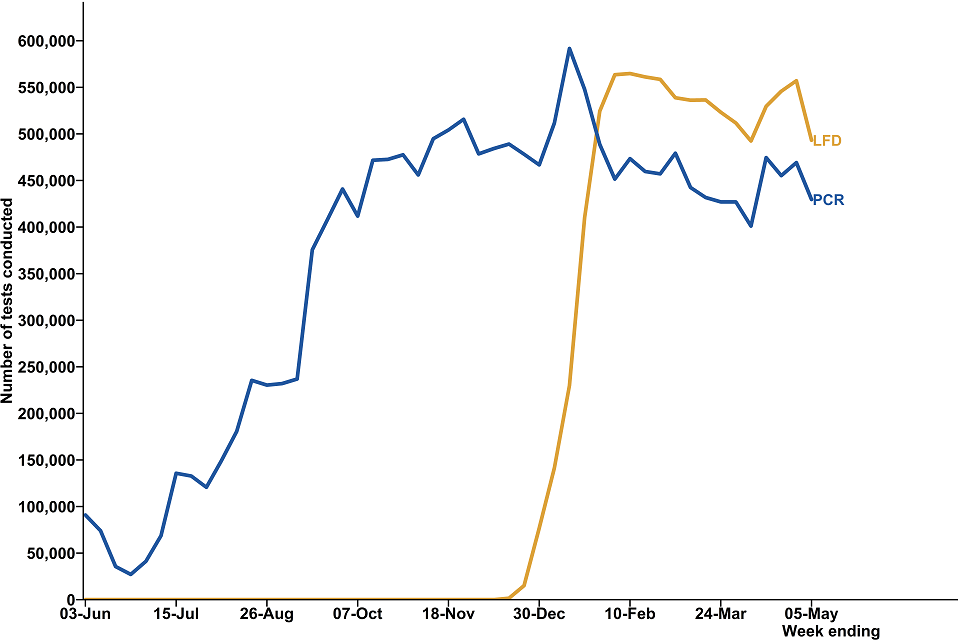
This data can be found in the ‘table_9’ and ‘table_10’ tab of the ‘Tests conducted: 28 May 2020 to 5 May 2021 data tables’ on the weekly collection page.
LFD testing in care homes by staff and residents
The number of LFD tests conducted by staff in care homes has decreased to 414,708 tests in the latest week from 451,427 tests in the previous week. Of these, 293 returned a positive result compared to 311 in the previous week.
Between 29 April and 5 May, 6,268 LFD tests were conducted by care home residents, which has decreased from 7,899 in the previous week. Of these, 3 returned a positive result compared to 6 in the previous week, continuing the downward trend from the previous week. Positive test results have been declining for the past 3 months.
Figure 5: number of LFD tests reported in care homes by organisation role, England
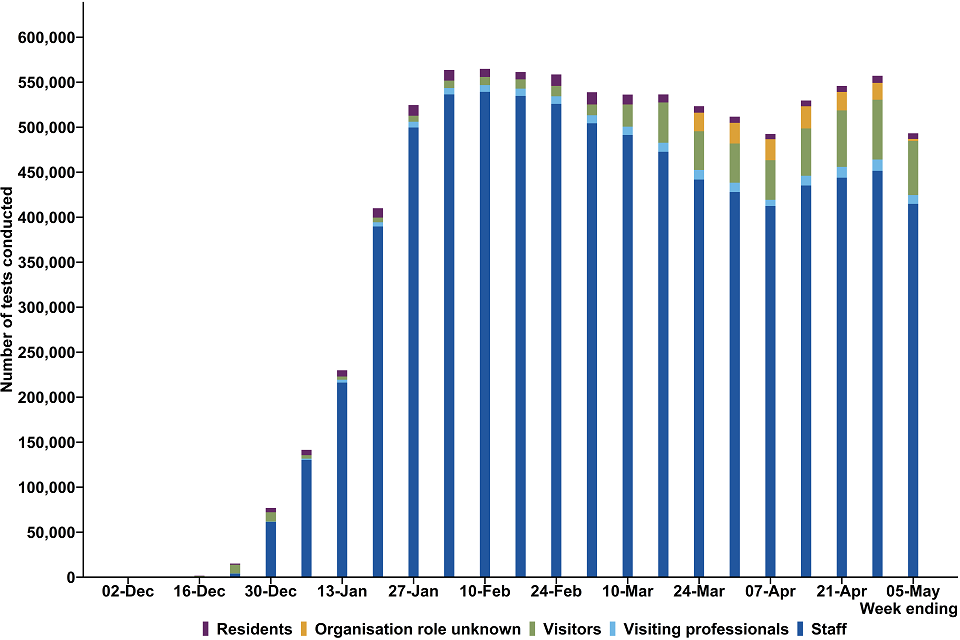
This data can be found in the ‘table_10’ tab of the ‘Tests conducted: 28 May 2020 to 5 May 2021 data tables’ on the weekly collection page.
LFD testing in care homes by visitors and visiting professionals
In the latest week 9,756 LFD tests were taken by visiting professionals in care homes, in comparison with 60,118 tests taken by visitors. The number of tests conducted by visitors increased steeply from week commencing 11 March, although the number of LFD tests decreased in the latest week (29 April to 5 May). This follows a change in the guidance on care home visits from 8 March.
LFD tests reported by NHS staff, England
Rapid asymptomatic testing by NHS staff began in November 2020 and has since expanded to include the following groups. All positive LFD test results in the NHS are followed up with a confirmatory PCR and contact tracing activities are trigged by the PCR test result.
| Group tested | Date | Frequency |
|---|---|---|
| Staff in NHS trusts | November 2020 | Twice weekly |
| Staff in primary care | December 2020 | Twice weekly |
| NHS-commissioned services in the independent sector | January 2021 | Twice weekly |
Staff in primary care and those in the independent sector delivering NHS services self-report their test result through the Test and Trace Gov.uk portal, whereas staff in NHS trusts report their results to their employer. The NHS trust then submits data for their staff to NHS Digital (formerly to PHE) which is separate to reporting through the National Testing Programme digital infrastructure. This separate reporting system was established this way because NHS secondary care providers began testing with LFD’s before an NHS Digital reporting solution for trusts was built; now it is available for them to use, these providers will be moving over to the specifically designed solution and will wind down the use of other systems. Because of this, the figures for NHS trusts are not included in the national figures for the number of LFD tests conducted reported via this route. We report them separately here.
Staff in NHS trusts and services are able to access additional forms of testing along with lateral flow testing, including asymptomatic testing with PCR and LAMP (loop-mediated isothermal amplification). NHS staff testing via these additional methods are not included in these figures.
The number of positive test results received by NHS staff is not published as a proportion of the total tests conducted because individuals test repeatedly and therefore cannot be compared with other testing regimes. See the ‘data quality’ section for more information.
For more information see the NHS Test and Trace statistics methodology.
LFD tests reported by NHS primary care staff
Primary care services provide the first point of contact in the healthcare system, acting as the ‘front door’ of the NHS. Primary care includes general practice, community pharmacy, dental and optometry (eye health) services.
The number of LFD tests reported by NHS primary care staff increased steadily between week commencing 7 January 2021 and week commencing 28 January to over 169,000 tests in a week. In the latest week, 112,710 LFD tests were reported by NHS primary care staff which has decreased from 127,340 in the previous week. 76 positive test results were returned in the latest week by NHS primary care staff, a decrease from 77 positive results in the previous week. Since LFD testing for primary care staff began, there have been a total of 2,515 positive test results.
LFD tests reported by staff in NHS trusts
NHS trusts include acute and specialist hospitals, community, mental health and learning disability and ambulance services. Staff in NHS trusts report their test results via their employer, which is separate to reporting through the National Testing Programme digital infrastructure. These tests are therefore not included in the total number of LFD tests conducted reported earlier in the bulletin.
The data collection process is entirely dependent on NHS organisations submitting complete information on time, as a result there are some data quality issues associated with the data. The figures for LFD tests conducted by staff in NHS trusts are therefore only available as a cumulative total number of tests up to 24 March. From 25 March all NHS trusts reported weekly to NHS Digital and the figures are reported weekly from this point forwards. For more information see the NHS Test and Trace statistics methodology
The timing of the weekly process of submission by NHS trusts means that data for the latest week is not available. Figures for tests conducted by staff in NHS trusts are therefore published with an additional week’s lag in comparison to the rest of the data in this publication.
From November 2020 to 24 March 2021 9,051,316 LFD tests have been reported by staff in NHS Trusts. Of these, 45,194 tests were positive, 8,971,263 were negative and 34,859 were unknown or void. In the latest week ending 28 April, 385,216 LFD tests were reported by staff in NHS Trusts of which 193 were positive.
LFD tests reported by other NHS staff (including the independent sector)
The majority of tests reported by other NHS staff, include members of staff working in the independent sector who have also had access to twice weekly LFD testing. In the latest week ending 5 May, 18,437 tests were conducted by other NHS employees which is a decrease from 19,431 tests in the previous week and 21 positive test results were received.
Within the NHS the majority of staff work in NHS trusts, followed by primary care and then the independent sector, hence testing volumes will reflect the number of staff working in each setting.
Figure 6: number of LFD tests reported by primary care NHS staff, staff in NHS trusts and other NHS staff, England
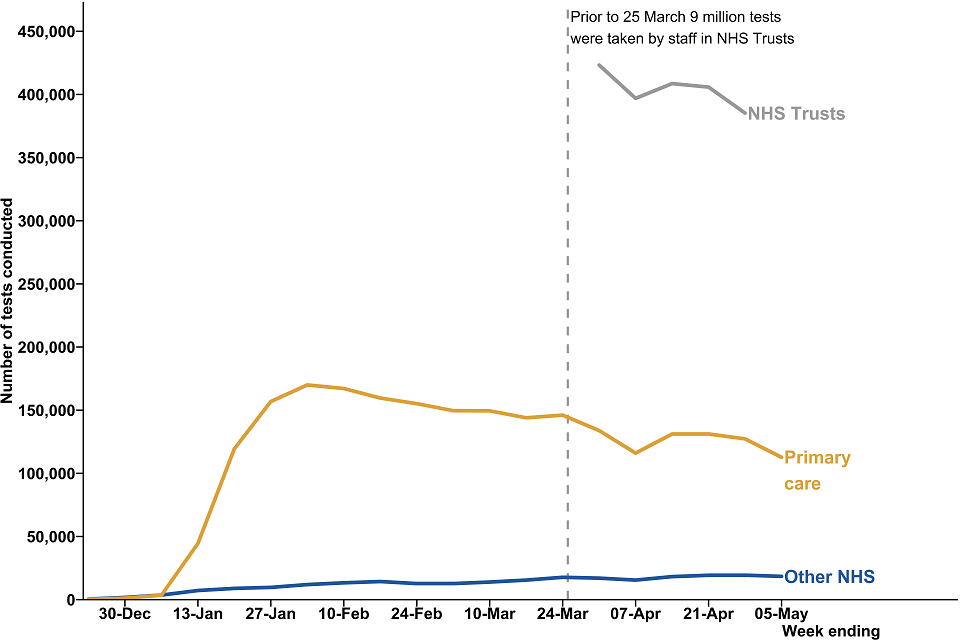
This data can be found in the ‘table_11’, ‘table_12’ and ‘table_13’ tabs of the ‘the ‘NHS Test and Trace statistics, 28 May 2020 to 5 May 2021 data tables’ on the weekly collection page.
About this data
Lateral flow device tests were first made available from 21 October 2020 in England. This data contains LFD tests reported through the existing National Testing Programme digital infrastructure and does not include LFD tests conducted where the tests were not registered via this route that is used to collect data for this report.
The following use cases for LFD tests are not currently reporting results digitally into Test and Trace systems, and therefore are excluded from this report:
- testing for some staff in private sector industries
- testing for some hauliers, these are published separately see haulier coronavirus testing
In these cases, test results should be reported directly into Public Health England. In future, all LFD tests will be reported via the existing National Testing Programme digital infrastructure and will be included.
A full explanation of the data sources and methods used to produce these statistics can be found in the NHS Test and Trace statistics methodology.
Data quality
Given the importance of this service and the commitment of NHS Test and Trace to be open and transparent with the public it serves, this data is being released at the earliest possible opportunity. However, this data should be treated with caution whilst the understanding of the data and its quality improves.
An LFD test produces a result on the device almost immediately, without it being automatically recorded, therefore some results might not be captured. For settings where self-reporting LFD testing procedures[footnote 5] are in place, it is likely that the number of tests conducted are underreported. It is however their statutory duty to do so, and easier reporting tools are being rolled out to support these individuals to report their tests as quickly and efficiently as possible. It is possible that tests with a negative result are more likely to be affected, therefore it is not advisable to calculate a positivity rate with the data.
Positive test results are not published as a proportion of the total number of tests conducted. There are several reasons why it is not advisable to calculate a positivity rate with this data:
-
the number of tests conducted is not deduplicated and refers to the number of tests taken and not the number of people tested. Because people can have more than one test, the number of tests conducted therefore cannot be compared with prevalence or case positivity rates
-
rapid testing is primarily used for repeat testing of asymptomatic individuals and the frequency of testing varies across different settings, therefore positivity rates would not be directly comparable
-
the potential underreporting of tests conducted by individuals self-reporting is more likely to affect negative test results than positives thus skewing any positivity rate calculation
More information on data limitations and how the figures in this publication can and cannot be used is outlined in the NHS Test and Trace statistics methodology.
Future developments
We continue to explore the feasibility of adding new breakdowns to the publication on rapid testing to support user needs. Over the coming months, we intend to make data available on the following:
-
confirmatory PCR test results for all positive LFD tests
-
rapid testing in public and private industries
-
community testing programme
For feedback and any further questions, please contact statistics@dhsc.gov.uk.
-
Counts of LFD tests conducted do not include tests which were not reported through the National Testing Programme digital infrastructure. The majority of those not included are tests taken by staff in NHS trusts which are reported separately in the publication. ↩
-
The number positive LFD tests returned by secondary school students published by whether they were self-reported or assisted at an asymptomatic test site (ATS) will not sum to the total number of LFD positives for secondary school students as published in the ‘table_7’ tab of ‘Tests conducted: 28 May 2020 to 5 May 2021’ on the weekly collection page. This is because the 2 use different data sources and the data cuts were taken at slightly different times, however the production process is being improved to address this. ↩
-
The number of LFD tests not matched to a confirmatory PCR test includes those where a confirmatory PCR test was not taken within 3 days of the LFD test, or where the LFD test could not be matched to a PCR test in the data. ↩
-
The data for confirmatory PCRs for LFDs taken at school-specific asymptomatic test sites can be found in the ‘table_8’ tab of ‘Tests conducted: 28 May 2020 to 5 May 2021’ on the weekly collection page. ↩
-
Self-reporting LFDs are where the individual carrying out the test on themselves is expected to report their own test and subsequent result. ↩
